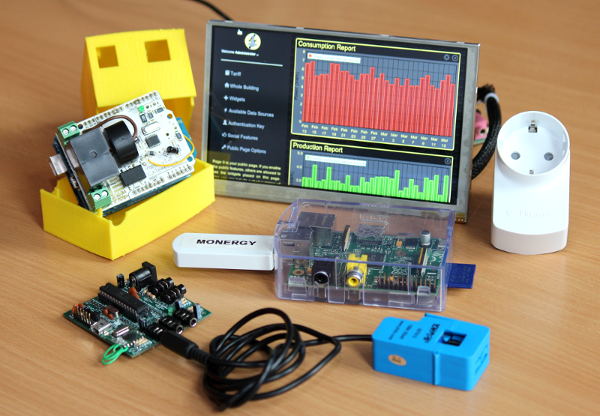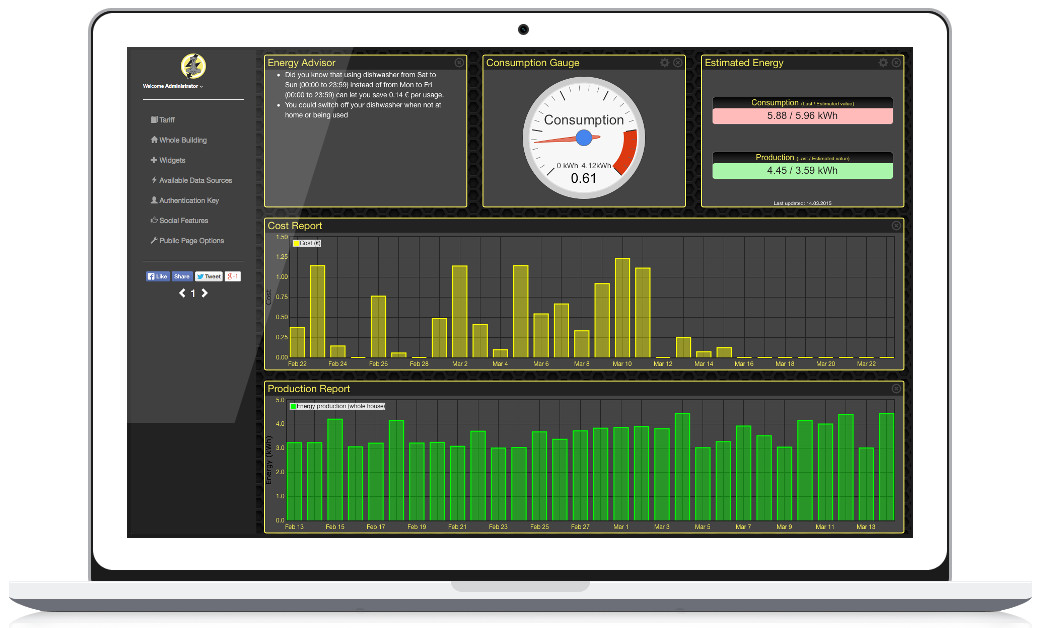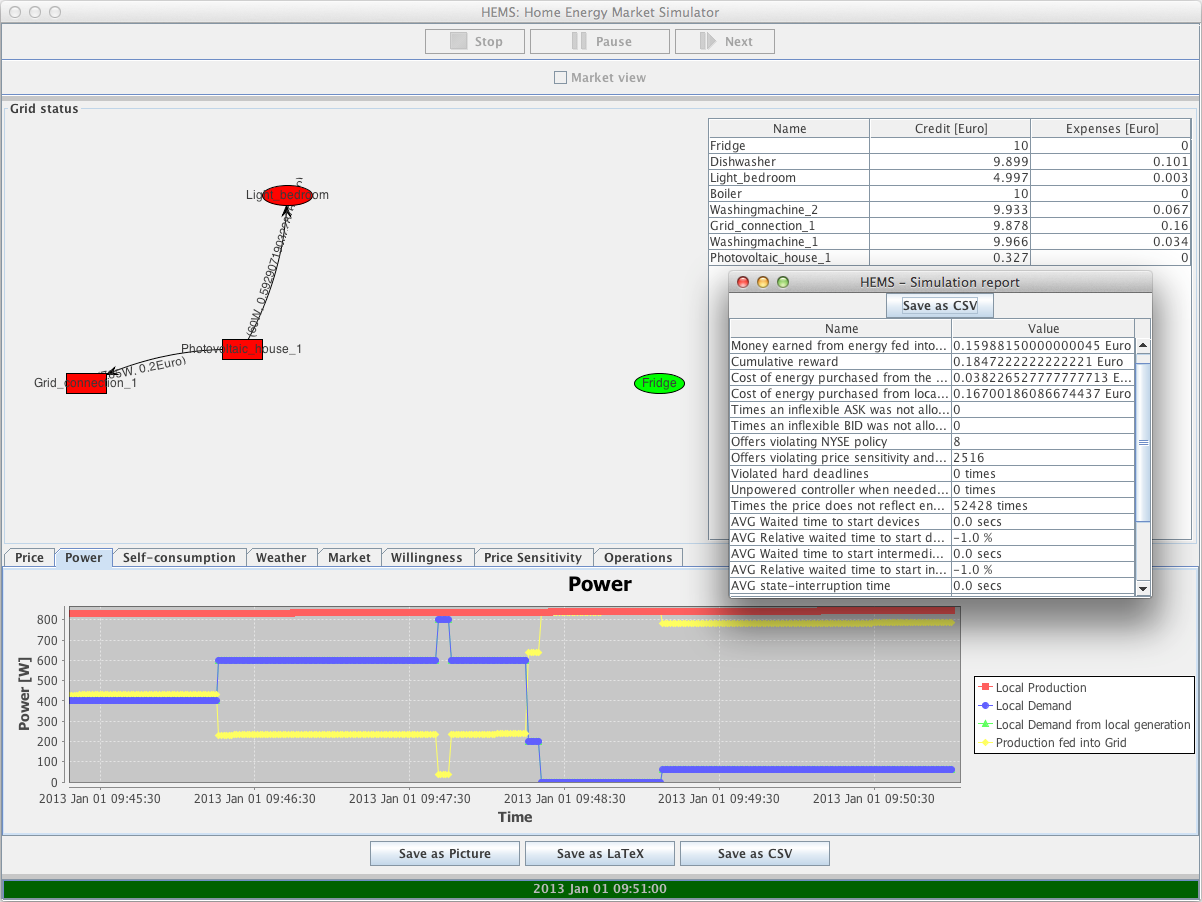Smart microgrids and energy management systems
Nowadays, the progressive installation of generation from renewable energy sources is increasing the complexity in maintaining the main grid due to the instability of renewable energy sources. The fragmentation of the system into smaller local grids can reduce the complexity introduced by distributed renewable generation, towards an overall self-organising smart grid. Energy management is performed based on a price signal reflecting energy availability and exchanged between energy producers and consumers.
In such a scenario, architectural reconfigurability provides a bottom-up approach to system design, scaling from small local grids, such as nano- and micro-grids, to the whole grid. Local energy networks could be used to enable energy sharing within communities of loads and micro producers of energy, such as in rural areas and in developing countries, where a power distribution network might be not available.
A significant part of my research activity was therefore devoted to the investigation of architectures allowing for the integration of smart appliances and legacy devices within local energy communities, as well as the annotation of produced data to allow its exploitation at an application level. Beyond the identification of a secure and service-oriented framework, this requires the modeling of a common vocabulary and data model, in order to allow distributed software components to communicate effectively across the energy management system. Specifically, we proposed a domain ontology for the description of device-specific information and services, as well as the specification of steady-state models usable in the context of load disaggregation.
Data produced in domestic environments while carrying out daily activities can be used to create profiles of inhabitants, possibly to predict future situations and needs, and act beforehand. Appliance usage modelling is the key enabler to better schedule energy consuming services. For this reason I have been collecting energy use information in residential environments in Austria and Italy, which resulted in the GREEND dataset.
While demand response can rely on the flexibility resulting from device operation, the success of this mechanism is heavily reliant on the exchange of information between the grid and the consumers. Customers are expected to react to dynamic energy prices so as to participate into the stabilization of the whole power grid. This demands for systems capable of monitoring production and consumption, as well as displaying such information to aid residents' decision making.
Part of my research is dedicated to the investigation of feedback means to involve and engage energy consumers, and also led to the initiation of the Mjölnir project, an open source dashboard for energy analytics. You can have a glimpse of our demo deployment running here (usr: "Administrator", pwd: "administrator").
Nevertheless expecting users to react to energy prices might not be a realistic solution to the problem of energy instability. Self-managing systems are therefore required to assist the scheduling of electrical loads, depending on the actual availability of energy. To this end, a relevant part of my research was devoted to the design of smart controllers for small energy prosumers, which communicate through an energy price within the local energy grid and aim at minimising operational costs and user's discomfort. Smart controllers can ensure a more efficient energy use, which has remarkable effects especially in small rural energy communities, where energy sharing becomes crucial to improve the overall system reliability and to reduce the need of storage facilities.
The HEMS simulator is meant to provide a testbed where demand response strategies can be simulated and controllers for energy prosumers (e.g. appliances, batteries, small generators) can be learned. In particular, the simulator focuses on double-side auctions. Moreover, we take advantage of the FREVO evolutionary computing framework. We specifically model controllers using artificial neural networks and train them using evolutionary computing algorithms (e.g. NNGA).
While the provided solution allows for power allocation over intervals of arbitrary duration, we are interested in providing a solution that can responsively handle changes in energy availability and demand peaks. In the latest research activities, we investigate in the design of power brokers able to price available power (i.e. resulting from multiple sources) according to the future expected demand and supply curves. The broker acts as a retailer and relieves the designer from the necessity of selecting an allocation interval big enough to prevent service interruption and small enough to prevent resource monopolisation.
These activities were finally collected in my dissertation:
Further activities in the Smart Energy field were undertaken during my experience at Power Reply, where I worked mainly on mobile-based energy analytics projects with German energy utilities. Our solutions allow energy consumers for a direct management of processes (e.g. meter reading, tariff selection, accounting, charting of consumption and production information) as well as the use of advanced services (e.g. coupons). This provides a platform for customer fidelization and retention, as well as collection and analysis of interaction logs. A few market possibilities are classified below:
Later on at Data Reply I had the chance to learn the whole Hadoop/Spark and Kafka ecosystems, in a number of Data Engineering projects. With this knowledge I then shifted back to more Data Science use cases, such as unsupervised fraud detection applied to set top box data and predictive mantainance (asset replacement priorization) of cable and middle-voltage substations.
Ambient Assisted Living
Papers are made available on this site to ease timely dissemination of research results. Copyright and all rights therein are retained by the authors or other copyright holders.
Tweet
Nowadays, the progressive installation of generation from renewable energy sources is increasing the complexity in maintaining the main grid due to the instability of renewable energy sources. The fragmentation of the system into smaller local grids can reduce the complexity introduced by distributed renewable generation, towards an overall self-organising smart grid. Energy management is performed based on a price signal reflecting energy availability and exchanged between energy producers and consumers.
In such a scenario, architectural reconfigurability provides a bottom-up approach to system design, scaling from small local grids, such as nano- and micro-grids, to the whole grid. Local energy networks could be used to enable energy sharing within communities of loads and micro producers of energy, such as in rural areas and in developing countries, where a power distribution network might be not available.
A significant part of my research activity was therefore devoted to the investigation of architectures allowing for the integration of smart appliances and legacy devices within local energy communities, as well as the annotation of produced data to allow its exploitation at an application level. Beyond the identification of a secure and service-oriented framework, this requires the modeling of a common vocabulary and data model, in order to allow distributed software components to communicate effectively across the energy management system. Specifically, we proposed a domain ontology for the description of device-specific information and services, as well as the specification of steady-state models usable in the context of load disaggregation.
- D. Egarter, A. Monacchi, T. Khatib, W. Elmenreich. Integration of Legacy Appliances into Home Energy Management Systems. Journal of Ambient Intelligence and Humanised Computing. August 2015.
- W. Elmenreich, A. Monacchi. Configuration and Management of Networked Embedded Devices, In Industrial Communication Technology Handbook, Second Edition, CRC Press, Boca Raton, FL 33431, USA, August 2014
- A. Monacchi, D. Egarter, W. Elmenreich. Integrating Households into the Smart Grid. In Proceedings of the IEEE Workshop on Modeling and Simulation of Cyber-Physical Energy Systems, Berkeley, CA, May 2013.
- S. D'Alessandro, A. M. Tonello, A. Monacchi, W. Elmenreich. Home Energy Management Systems: Design Guidelines for the Communication Infrastructure. In Proceedings of the IEEE International Energy Conference (ENERGYCON 2014). Dubrovnik, Croatia, May 2014.
Data produced in domestic environments while carrying out daily activities can be used to create profiles of inhabitants, possibly to predict future situations and needs, and act beforehand. Appliance usage modelling is the key enabler to better schedule energy consuming services. For this reason I have been collecting energy use information in residential environments in Austria and Italy, which resulted in the GREEND dataset.
- A. Monacchi, D. Egarter, W. Elmenreich, S. D'Alessandro, A. M. Tonello. GREEND: An Energy Consumption Dataset of Households in Italy and Austria. In Proceedings of the 5th IEEE International Conference on Smart Grid Communications (SmartGridComm 14), Venice, Italy, November 2014.
- Lakeside Labs, WiTiKee Srl. Validation and analysis of results. Monergy 4th technical report. 2015
While demand response can rely on the flexibility resulting from device operation, the success of this mechanism is heavily reliant on the exchange of information between the grid and the consumers. Customers are expected to react to dynamic energy prices so as to participate into the stabilization of the whole power grid. This demands for systems capable of monitoring production and consumption, as well as displaying such information to aid residents' decision making.
Part of my research is dedicated to the investigation of feedback means to involve and engage energy consumers, and also led to the initiation of the Mjölnir project, an open source dashboard for energy analytics. You can have a glimpse of our demo deployment running here (usr: "Administrator", pwd: "administrator").
- A. Monacchi, F. Versolatto, M. Herold, D. Egarter, A. M. Tonello, and W. Elmenreich. An open solution to provide personalized feedback for building energy management. ArXiv preprint arXiv:1505.01311, 2015. (to appear on the IOS Journal of Ambient Intelligence and Smart Environments)
- A. Monacchi, W. Elmenreich, S. D"Alessandro, A. M. Tonello. Strategies for Domestic Energy Conservation in Carinthia and Friuli-Venezia Giulia. In Proceedings of the 39th Annual Conference of the IEEE Industrial Electronics Society (IECON), Vienna, Austria, 2013.
- A. Kercek, W. Elmenreich und A. Monacchi. Energieverbrauch in den Regionen Kärnten, Österreich und Friaul-Julisch-Venetien, Italien - Ein Vergleich. In 13. Symposium Energieinnovation. Graz, Austria, Februar 2014.
- T. Khatib, A. Monacchi, W. Elmenreich, D. Egarter, S. D'Alessandro, A. M. Tonello. European end-user's level of energy consumption and attitude toward smart homes: A case study of residential sectors in Austria and Italy. Energy Technology & Policy, Taylor & Francis.
- A.Monacchi, W.Elmenreich. Insert-coin: turning the household into a prepaid billing system. In Proceedings of the 5th ACM Workshop on Embedded Systems for Energy-Efficient Buildings (BuildSys13), Roma, Italy, 2013. Poster
Nevertheless expecting users to react to energy prices might not be a realistic solution to the problem of energy instability. Self-managing systems are therefore required to assist the scheduling of electrical loads, depending on the actual availability of energy. To this end, a relevant part of my research was devoted to the design of smart controllers for small energy prosumers, which communicate through an energy price within the local energy grid and aim at minimising operational costs and user's discomfort. Smart controllers can ensure a more efficient energy use, which has remarkable effects especially in small rural energy communities, where energy sharing becomes crucial to improve the overall system reliability and to reduce the need of storage facilities.
The HEMS simulator is meant to provide a testbed where demand response strategies can be simulated and controllers for energy prosumers (e.g. appliances, batteries, small generators) can be learned. In particular, the simulator focuses on double-side auctions. Moreover, we take advantage of the FREVO evolutionary computing framework. We specifically model controllers using artificial neural networks and train them using evolutionary computing algorithms (e.g. NNGA).
- A. Monacchi, S. Zhevzhyk, W. Elmenreich. HEMS: A Home Energy Market Simulator. Computer Science - Research and Development. Springer.
Appended technical reports:
- W. Elmenreich, T.Khatib. A.Monacchi. Smart Microgrids: Optimizing Local Resources toward Increased Efficiency and a More Sustainable Growth. InTech 2017
While the provided solution allows for power allocation over intervals of arbitrary duration, we are interested in providing a solution that can responsively handle changes in energy availability and demand peaks. In the latest research activities, we investigate in the design of power brokers able to price available power (i.e. resulting from multiple sources) according to the future expected demand and supply curves. The broker acts as a retailer and relieves the designer from the necessity of selecting an allocation interval big enough to prevent service interruption and small enough to prevent resource monopolisation.
- A. Monacchi, W. Elmenreich. Assisted Energy Management in Smart Microgrids. Springer Journal of Ambient Intelligence and Humanised Computing, July 2016. DOI: 10.1007/s12652-016-0392-1 )
These activities were finally collected in my dissertation:
- A. Monacchi Assisting Energy Management in Smart Microgrids and Buildings. PhD Thesis. Alpen-Adria-Universität Klagenfurt. June 2016. The dissertation was defended on September 2016, in front of a committee including Prof. Gerhard Leitner, Prof. Sebastian Lehnhoff and Prof. N. Wohlgemuth.
Further activities in the Smart Energy field were undertaken during my experience at Power Reply, where I worked mainly on mobile-based energy analytics projects with German energy utilities. Our solutions allow energy consumers for a direct management of processes (e.g. meter reading, tariff selection, accounting, charting of consumption and production information) as well as the use of advanced services (e.g. coupons). This provides a platform for customer fidelization and retention, as well as collection and analysis of interaction logs. A few market possibilities are classified below:
- consumption and cost itemization
- optimal tariff selection
- persuasive interfaces (e.g. energy advisors)
- frequent meter reading via OCR
- in-app eventing mechanisms (e.g., anomalous consumption/production)
- targeted advertising and partner-provided coupons
Later on at Data Reply I had the chance to learn the whole Hadoop/Spark and Kafka ecosystems, in a number of Data Engineering projects. With this knowledge I then shifted back to more Data Science use cases, such as unsupervised fraud detection applied to set top box data and predictive mantainance (asset replacement priorization) of cable and middle-voltage substations.
Ambient Assisted Living
- A. Monacchi, An early warning system for ambient assisted living. Master of Science in Computer Science, School of Computer Science, Reykjavík University, June 2012. - Early Warner v0.2
Daily-life activities at home can generate dangers that may lead to accidents.
Risky situations may be difficult to notice by people with a cognitive or physical impairment.
Therefore, recognizing dangers is very important so as to assist users in preventing accidents, and ensure their health, safety and wellbeing.
The present thesis aims to design a system that, given a representation of the environment as input, learns how to evaluate states according to their danger level, and is able to alert and prevent users from getting too close to a potential danger. We explore the search space for disclosing dangers and finding a safe path leading to the goal. The project led to the implementation of a working prototype, which is able to suggest the best action to perform, and reports the level of danger and an evaluation of the last performed action. Also, it is able to warn the user when the level of danger exceeds a given threshold.
We offer a general solution, as the system is able to play arbitrary games described with the Game Description Language, and perform on-line planning by means of the Q(lambda) algorithm. For this purpose, we implemented a Java library for implementing TD-learning agents. In addition, we defined the concept of sphere of protection and we disclose dangers by using a variant of breadth-first search.
Finally, we exploited virtual environments as a general testbed for simulating effects of warning notifications and we conducted informal user testing for evaluating the effects of warning notifications on actual users.
- A.Monacchi. Analisi di un sistema operativo per dispositivi a memoria limitata: applicazione alla misura di parametri ambientali. Bachelor thesis in Applied Computer Science. Università degli studi di Urbino "Carlo Bo". Ottobre 2010.
Papers are made available on this site to ease timely dissemination of research results. Copyright and all rights therein are retained by the authors or other copyright holders.
Tweet






